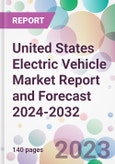According to the report, the United States electric vehicle market is projected to grow at a CAGR of 24.6% between 2024 and 2032. Aided by the heightened emphasis on sustainable transportation solutions and the federal administration's push for greener alternatives, the market is expected to grow significantly by 2032.
Electric vehicles, categorised under battery electric vehicles (BEVs), plug-in hybrid electric vehicles (PHEVs), and hybrid electric vehicles (HEVs), represent the frontier of automotive innovation in the U.S. These vehicles not only promise to reduce the nation's carbon footprint but also cut down on dependency on fossil fuels, paving the way for a sustainable energy future.
One of the primary factors accelerating the United States electric vehicle market growth is the consumers' rapidly evolving perspective towards sustainable transportation. As awareness regarding the environmental consequences of traditional gasoline vehicles amplifies, American consumers are increasingly leaning towards electric alternatives. The collective realisation of the environmental benefits such as reduced greenhouse gas emissions and lesser air pollutants is setting the stage for EVs to become mainstream.
As per the United States electric vehicle market analysis, the surge in the fitness and health-conscious culture has trickled down to environmental consciousness. Just as people are mindful of their dietary intake, they are becoming equally conscious of their carbon footprint. As a result, electric vehicles, which once were seen as niche or luxury items, are becoming popular choices for daily commuting.
Industry-wise, the automotive sector is witnessing a seismic shift in manufacturing. Established automobile giants and emerging startups alike are investing heavily in research and development, battery technologies, and infrastructure development, which further propels the United States electric vehicle market demand. Notably, battery technology advancements are particularly significant, as they directly influence the vehicle's range, charging time, and overall performance. Enhanced battery life and reduced charging times are continuously making EVs more viable for longer journeys and everyday use.
The U.S. government is also playing a pivotal role in shaping the electric vehicle landscape. Federal tax incentives, rebates on EV purchases, investments in charging infrastructure, and mandates for federal fleets to adopt electric vehicles underscore the administration's commitment to a greener transportation future and contribute to the United States electric vehicle market size.
Electric vehicles, categorised under battery electric vehicles (BEVs), plug-in hybrid electric vehicles (PHEVs), and hybrid electric vehicles (HEVs), represent the frontier of automotive innovation in the U.S. These vehicles not only promise to reduce the nation's carbon footprint but also cut down on dependency on fossil fuels, paving the way for a sustainable energy future.
One of the primary factors accelerating the United States electric vehicle market growth is the consumers' rapidly evolving perspective towards sustainable transportation. As awareness regarding the environmental consequences of traditional gasoline vehicles amplifies, American consumers are increasingly leaning towards electric alternatives. The collective realisation of the environmental benefits such as reduced greenhouse gas emissions and lesser air pollutants is setting the stage for EVs to become mainstream.
As per the United States electric vehicle market analysis, the surge in the fitness and health-conscious culture has trickled down to environmental consciousness. Just as people are mindful of their dietary intake, they are becoming equally conscious of their carbon footprint. As a result, electric vehicles, which once were seen as niche or luxury items, are becoming popular choices for daily commuting.
Industry-wise, the automotive sector is witnessing a seismic shift in manufacturing. Established automobile giants and emerging startups alike are investing heavily in research and development, battery technologies, and infrastructure development, which further propels the United States electric vehicle market demand. Notably, battery technology advancements are particularly significant, as they directly influence the vehicle's range, charging time, and overall performance. Enhanced battery life and reduced charging times are continuously making EVs more viable for longer journeys and everyday use.
The U.S. government is also playing a pivotal role in shaping the electric vehicle landscape. Federal tax incentives, rebates on EV purchases, investments in charging infrastructure, and mandates for federal fleets to adopt electric vehicles underscore the administration's commitment to a greener transportation future and contribute to the United States electric vehicle market size.
Market Segmentation
The market can be divided based on type, vehicle class, vehicle type, and region.
Market Breakup by Type
- BEV
- PHEV
- FCEV
Market Breakup by Vehicle Class
- Mid-Priced
- Luxury
Market Breakup by Vehicle Type
- Passenger Cars
- Commercial Vehicles
Market Breakup by Region
- New England
- Mideast
- Great Lakes
- Plains
- Southeast
- Southwest
- Rocky Mountain
- Far West
Competitive Landscape
The report looks into the market shares, plant turnarounds, capacities, investments, and mergers and acquisitions, among other major developments, of the leading companies operating in the United States electric vehicle market. Some of the major players explored in the report are as follows:- Tesla, Inc
- FCA Italy S.p.A (Fiat)
- BMW AG
- Volkswagen Group
- Hyundai Motor Company,
- AB Volvo
- Mercedes-Benz Group AG
- Ford Motor Company
- Toyota Motor Corporation
- General Motors
- Renault-Nissan-Mitsubishi
- Others
Table of Contents
1 Preface2 Report Coverage - Key Segmentation and Scope4 Key Assumptions6 Market Snapshot7 Industry Opportunities and Challenges12 Key Trends and Developments in the Market
3 Report Description
5 Executive Summary
8 United States Electric Vehicle Market Analysis
9 Regional Analysis
10 Market Dynamics
11 Competitive Landscape
List of Figures and Tables
Companies Mentioned
- Tesla Inc
- FCA Italy S.p.A (Fiat)
- BMW AG
- Volkswagen Group
- Hyundai Motor Company
- AB Volvo
- Mercedes-Benz Group AG
- Ford Motor Company
- Toyota Motor Corporation
- General Motors
- Renault-Nissan-Mitsubishi








